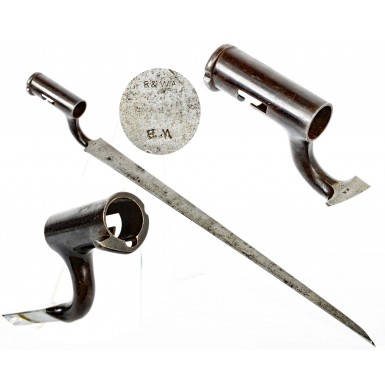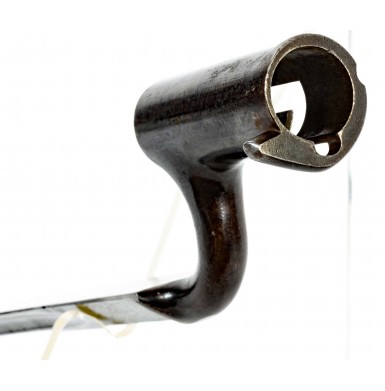British Pattern 1851 Minié Rifle Socket Bayonet - Extremely Rare
- Product Code: EWB-2533-SOLD
- Availability: Out Of Stock
-
$1.00
The Pattern 1851 Minié Rifle is one of the least often encountered of all general issue British military percussion long arms. The gun was the first rifled percussion arm to be widely issued to the British line infantry, replacing the smoothbore Pattern 1842 percussion musket, and foreshadowing the end of the Napoleonic Era “rifle regiment”. The gun was adopted in 1851 and was manufactured from 1852 through 1855, with some 35,000 total rifle muskets being produced. It appears that nearly every one of the P1851s saw service, as arms researcher and author DeWitt Bailey notes that by April of 1855 approximately 34,000 P1851s were issued for service. At the beginning of the Crimean War, the P1851 was the most advanced weapon in the British military small arms arsenal. It retained much of the styling of the earlier P1842 musket, with a barrel secured by keys (wedges), and brass pipes to retain the ramrod. Unlike the .75 caliber P1842, the gun had a slightly smaller bore, measuring .708 and a 39” long barrel that was rifled with four broad, fairly deep grooves of uniform depth. An adjustable long-range rear sight was affixed to the upper rear of the barrel, which was graduated to a maximum distance of 900 yards. The balance of the gun was essentially the same as the earlier pattern smoothbore percussion muskets that it was designed to replace.
The Pattern 1851 Minié Rifles performed fairly well in the Crimea but were quickly supplanted by the newly adopted Pattern 1853 “Enfield” Rifle Musket. This gun was a major advance in infantry long arm design and featured a reduced caliber bore of .577, a more advanced rear sight and a barrel secured by clamping barrel bands, instead of the P1851’s wedges. The P1851 was so quickly replaced by the new technology of the “Enfield” that at the conclusion of the Crimean War the guns were considered completely obsolete. The hierarchy of the British military expected long arms to have a useable service life of 10 years and required even obsolete weapons to be held in reserve for emergency issue for at least that long before being offered for sale. The Pattern 1851 Minié Rifle was held in such low regard after the adoption of the P1853 that the many of the guns were “stored” outside, exposed to the weather in an area adjacent to the Tower of London known simply as “the ditch”. More than likely this “storage area” was in fact the old moat that surrounded the Tower in earlier days, and it appears that due to a poorly managed and somewhat corrupt ordnance supply system, much of the surplus materiel from the war in the Crimea suffered a similar fate.
With the coming of the American Civil War, and the urgent need for infantry long arms by both sides, a large number of obsolete British arms were sold as surplus, most of which were sold to the Confederacy by S. Isaac, Campbell & Company. According to Confederate purchasing records, some 14,900 British Pattern 1851 Minié Rifles were purchased during the early days of the war. Most of these arms were purchased between August of 1861 and January of 1862, with a handful purchased in the summer of 1862. Records indicate that at least 10,000 of these arms (and probably all of them) were purchased from J.E. Barnett & Sons of London, who had acquired the guns from the British Ordnance Department. Due to the fact that the arms had been left exposed to the elements in the Tower ditch for several years, Barnett refurbished the guns to make them functional. This apparently included the replacement of worn, damaged or missing parts and also involved re-proving the guns at the London Proof House. It is also likely that bayonets had to be contracted for to provide with the guns, as many of the bayonets were no doubt missing, damaged or unserviceable due to exposure to the weather. All known examples of Confederate imported Pattern 1851 Minié Rifles show a set of London commercial proofs, applied during the Barnett refurbishment process, in addition to their original British military proofs, or their remnants. Barnett sold the majority of these arms to S. Isaac & Campbell at a rate of 40 shillings each, including the socket bayonet, and the Confederacy was charged 44 shillings, a simply 10% mark up for handling the sale. The summer of 1862 purchases were sold to the Confederacy at the lower rate of 40 shillings each. The guns were inspected by Messrs. Curtis and Hughes, who had been hired by S. Isaac & Campbell to act as viewers of arms. The P1851s inspected by Curtis & Hughes bear the inspection mark of CH / 1 in a small circle, on the upper comb of the stock, forward of the buttplate tang. Confederate documents refer to the Pattern 1851 rifle muskets by a number of different names, including “Old Army Pattern, rifled,” “Second-Hand Government Rifles,” “Minié Rifles,” “Second-Hand Rifles 1851 Pattern,” “Brown Bess Rifles 1851 Pattern” and “Rifled Brown Bessies.” Pattern 1851 Rifle Muskets were arriving in Confederate ports no later than January of 1862, with deliveries continuing throughout most of that year. According to the McRae Papers, P1851s were included in the cargos of the blockade runners Gladiator, Harriett Pinckney, Southwick,Stephen Hart and Ella Warley. While the guns that were aboard the Ella Warley and Stephen Hart (some 3,520 guns) were lost to capture by the Federal blockading squadron, 11,380 Pattern 1851 Minié Rifles were successfully delivered to Confederate ports and were subsequently issued for service. These guns had already seen hard use in the Crimea and saw additional hard service in Confederate hands. The end result is that the Pattern 1851 Minié Rifle is now a rarely encountered weapon and to my knowledge, only about twenty Confederate marked P1851s are known to exist today.
The only item related to the Pattern 1851 Minié Rifle that is scarcer on the market than the gun itself is its accompanying socket bayonet. The Pattern 1851 Socket Bayonet. The standard P1851 bayonet was an adaptation of the British Pattern 1842 Socket Bayonet that had been in use with the British military previously. Only two dimensional changes were made to the new P1851 bayonet when compared to the earlier P1842. First, the muzzle diameter of the new bayonet was reduced to .87” from .945”. This was a result of the reduced .708” caliber of the P1851 versus the earlier .75” caliber P1842. Secondly, the muzzle to stud distance was reduced on the new P1851 bayonet because the P1851’s front sight was placed closer to the muzzle than the bayonet stud was on the P1842. This new distance was only 1.2”, versus the earlier 1.6”. Otherwise the bayonets are visually nearly identical with an overall length of 21”, an 18” triangular blade and a 3” socket with a three step mortise and no locking ring. The bayonet was secured by an eccentric ridge on the rear edge of the socket that engaged the Lovell bayonet catch under the muzzle of the musket. Like most British socket bayonets of the period the construction was of a combination of iron and steel with the iron socket and neck blued and the steel blade left bright.
The first 18,000 P1851 bayonets were actually modified from existing stocks of P1842 bayonets by having their sockets shrunk by a process of heating and cooling and having the third step of the bayonet’s mortise cut an additional .4” to get the right muzzle to stud distance. Additional bayonets were supplied by the various British Ordnance Department contractors in Birmingham, as none of the bayonets were produced at Enfield. British military examples were inspected, typically with a {CROWN} / B / 7. Those bayonets produced for commercial sale were not inspected. For whatever reason, the survival rate of these bayonets is extremely low, and over the last two decades I have had the opportunity own and sell seven or eight P1851s, but this is only the second P1851 bayonet I have ever had the opportunity to offer for sale.
Offered here is a FINE condition example of a scarce Pattern 1851 Minié Rifle Socket Bayonet. The bayonet is a commercial example, not a British military inspected example and is marked by the contractors who delivered the bayonet, Richard & William Aston. The face of the bayonet is marked R&W A about .5” from the shank. The firm of Richard & William Aston was a long time Birmingham based gunmaker who not only produced complete arms, but also supplied gun locks, gun furniture, ramrods, bayonets and gun tools to the trade. The blade is additionally marked WBnear the blade to shank joint. The firm operated under the R&W Aston name from 1845 through 1870. This suggests that the bayonet was actually produced by a Belgian contractor whose initials were WB and then sold by R&W Aston. The lack of British military inspection marks and the presence of Belgian contractor marks suggest to me that this may have been one of the bayonets that had to be obtained by Barnett to replace damaged or missing P1851 bayonets for their Confederate contract. The condition of the bayonet suggests that it saw little use and may have been part of the cargos of 3,520 P1851s that were captured by the Union while the Confederate ships were trying to run the blockade.
As noted, the bayonet is in FINE condition and shows little use. The socket and shank retain about 80% thinning blue and are in fine condition with no pitting and with both ends of the socket remaining perfectly round. The blade has a medium pewter gray patina and shows scattered minor pinpricking along its face, as well as scattered flecks of darker age oxidation and discoloration. The bayonet blade is full-length and remains quite sharp at the tip. The markings on the blade remain clear and legible. The bayonet fits a CH/1 marked Confederate Pattern 1851 Minié Rifle, which I happen to have on hand, perfectly.
Overall this is a wonderful example of a scarce British Pattern 1851 Minié Rifle Socket Bayonet by marked by R&W Aston that was almost certainly imported along with the nearly 15,000 Pattern 1851 Minié Rifles that were purchased by the Confederacy. This is an extremely rare bayonet that is rarely found for sale and it would be a fantastic addition to the display of your Pattern 1851 Minié Rifle.
SOLD
Tags: British, Pattern, 1851, Minie, Rifle, Socket, Bayonet, Extremely, Rare






